An Essay Towards A Topographical History of the County of Norfolk: Volume 1. Originally published by W Miller, London, 1805.
This free content was digitised by double rekeying. All rights reserved.
'Hundred of Shropham: Great Elingham', in An Essay Towards A Topographical History of the County of Norfolk: Volume 1, (London, 1805) pp. 482-490. British History Online https://www.british-history.ac.uk/topographical-hist-norfolk/vol1/pp482-490 [accessed 16 April 2024]
In this section
GREAT ELINGHAM.
This town was in three parts at the Conquest, and hath continued so to this time, there being now three manors; the capital manor was always called, as it now is,
Elingham, or Elingham Hall.
It belonged to Turketel the Dane in the Confessor's days, and to Waribold, or Warbold in the Conqueror's, who held it of Hermer de Ferrers, to whom the Conqueror had given it; (fn. 1) it was then worth 5l. and the whole town was two miles long and one broad, and paid 19d. geld.
The said Hermer seized also three freemen, (fn. 2) and 110 acres, besides other lands and services in this town, and Warbold added them to this manor, to which they afterwards belonged as to their services, but the soke belonged to Bukenham castle. It after came to the Earl Warren, of whom the Wirmegeyes held it, till William de Wormegeye infeoffed William, son of Ralph de Elingham, (fn. 3) and in 1252, Robert de Elingham held it at two fees, of Sir Hugh Bardolph, and had a charter for free-warren; he was succeeded by Alex. de Elingham, who had the charter allowed in Eire in 1285, Robert de Elingham was lord after him, and settled it in 1313, on himself and Cassandra his wife, for life, remainder to his own heirs; in 1369, Alexander his son was lord and patron, who conveyed the whole manor and advowson to Sir Robert Mortimer, Knt. and Dame Margery his wife; and in 1372, according to the agreement on the sale, they regranted the manor (except eight acres and the advowson) to the said Alexander and Amy his wife, for their lives, remainder to the said Sir Robert and Margery his wife, who settled the reversion on William atte Wend, parson of Skulton, Tho. Caus of Hocham, and John, son of Tho. Wottes of Attleburgh, their feoffees, who released to them in 1377; and in 1381, Sir Robert was lord and patron; in 1388, Margery his widow settled both the manor and advowson on Sir George Felbrigge, Knt. Will. de Sharneburn, Henry de Pakenham, William atte Wend, parson of Great Elyngham, John, parson of the third part of Attleburg, Richard Caus of Hocham, Richard Gegge of Saham, and John atte Cross of Depham, by deed dated at Great Elingham, under her seal, which is remarkable for its having her own arms, viz. a chevron between three lions rampant, impaled with, and placed before, those of her husband. In 1399, the feoffees released their right to her again. In 1401, Constantine Mortimer was lord and patron; in 1402, the advowson was separated from the manor, as you may see in the account of the incumbents, and the manor went to Sir John FilzRalph of Scoulton, Knt. in right of Margery his wife, one of the daughters and coheiresses of Sir Thomas Mortimer of Attleburgh, from whom it descended to John Fitz-Ralph, Esq. his son, who settled it, with Scoulton and Totyngton, on John Fitz-Ralph, his son, and Alice Walesborough his wife, after the deaths of himself, and Julian his then wife, with remainder to the sons heirs male, and for want of such, on Maud his daughter, and her heirs, Richard de Beauchamp Earl of Warwick, Sir William Phelep, Sir John Fastolff, Sir John Howard, Sir Richard Waldgrave, senior, and Sir Tho. Tudenham, Knts. Will. Clopton, Henry Pakenham, Esqrs. and others, being feoffees; and, for want of issue male, they went to Maud Fitz-Ralph, who married Sir Robert Conyers, Knt. who died seized, and John Conyers, their son, inherited; he married Eleanor, sister and coheir of William, son of Sir William Yelverton, Knight of the Bath, at King Edward the Fourth's coronation, and one of the justices of the King's Bench; but having no issue, in 1472, he released it to Henry Spelman, in trust for Thomas his son, who had married Anne, one of the two daughters and coheirs of Tho. Conyers, Esq. his brother; he died in 1483: "And in 1499, Thomas Spelman, Gentylman, of "Mekyll Elyngham" held it of Shropham hundred, who died seized, and by his will dated this year, ordered to be buried in the church, to which he gave 20l. for a suit of vestments, "and to the gild of our Lady, in honowr and worschypp of her v. joyes, 5s. to St. James's gild 10s. and to St. Peter's 6s. 8d." (fn. 4) to Anne his wife the manor of Chervells in Bichamwell, till John his son was 21 years old, to Henry his son, and Elizabeth his daughter 100 marks each, to Anne his wife, the manor of Berryhall in Elyngham, and after her decease to his son John in fee tale, who died under age, and Henry his brother inherited; he died without issue in 1525, and was buried here, by Anne his mother, upon which, this manor went to Anthony Gourney, Esq. of North Barsham, in right of Margaret his wife, one of the daughters and coheirs of Sir Robert Lovell, by Ela Conyers his wife, who was sister to Anne Coniers, mother to Henry Spelman; but Berryhall went to the heirs of William De-Grey of Merton, in right of Christian his wife, the daughter and coheir of Thomas Manning, as you may see under Buryhall manor. Francis Gurney, son of Anth. Gourney of Elyngham, Esq. married Helen, daughter of Robert Holdiche of Ranworth, Esq. and died before his father, leaving (fn. 5) Henry Gurney, Esq. his son and heir, who held Irsted manor of the Bishop Norwich, Elingham manor of the Lord Bardolf's heirs, West Barsham of the manor of Castle-Acre, by one fee, Gurney's manor in Hingham, of the heirs of Henry Lord Morley, as of his manor of Hingham, and the advowson of the third part of Attleburgh; he was lord in 1572, and at his death it went to Edm. Gurney, Esq. his son and heir, who died seized in 1641, and left Henry his son and heir, then nine years old, who died without issue, and it went to Margaret Gurney, his aunt, who married Mr. Henry Davy of Great Elingham, whose sole daughter and heiress, Mary, married Sir Roger Potts, Bart. of Great Elingham and Mannington, who sold it to Mr. Francis Colman of Norwich, the present lord, who now dwells in the manor-house called Ellingham Hall.
The Customs of this manor are, that the eldest son is heir; it is set fine at 3s. an acre, and there are very considerable barley rents paid in kind, if the lord does not choose to compound for them. The leet belongs to the hundred, the leet fee being 3s. 6d. 3q. as the hundred-roll informs me.
Burgh Hall, or Berry Hall Manor,
At the conquest belonged to Robert de Beaufo; (fn. 6) the soke of it was then appendant to the hundred, as it now is, there being no leet; it afterwards belonged to the lords of Bukenham castle, and was part of those eleven fees which Hugh de Vere and Dionise his wife held of Robert de Tateshale; and in 1304, Tho. de Cayly had it. In 1805, it belonged to Baldwin de Manerijs, or Manors, who held it of Roger Bigot Earl of Norfolk; in 1314, Simon, son of John Skilman of Hedersete, granted to Margery, relict of Roger Cosyn of Great Elingham, his mother, the manor and all its appurtenances, viz. 15 messuages, 320 acres of land, 100s. rent, &c. in Great and Little Elingham, Hingham, Attleburgh, Rockland, Depham, and Morley; and in 1315, the said Margery and Ralph Ponyant (whom she had married) owned it; in 1345, Roger de Gatesend had it; and in 1399, Baldwin de Bosco, or Bois, held it at half a fee, as of Forncet manor, (fn. 7) and soon after it belonged to the Mortimers, and went with Elizabeth Mortimer to Sir Ralph Bigot of Stockton, her husband, who held it for life, and after his death she enjoyed to her own, in 1463, and then by will gave it to John Manning, her last husband, and his heirs; who, in 1428, was justice of peace, and of goal delivery in the Bishop of Ely's liberty of Mitford hundred; at his death it went with Christian, one of his daughters and coheirs, to William De-Grey of Merton, Esq. (fn. 8) who died in 1474, as his inscription in Merton church informs me, from which time it hath gone in a lineal descent to Thomas De-Grey of Merton, Esq. the present lord, of whose family I shall discourse under Merton, their ancient seat.
The Custom of the manor is, that the fines are at the lord's will, and the eldest son is heir.
This Church was valued in the Kings Books at 6l. 5s. 10d. and being sworn of the clear yearly value of 31l. 16s. 10d. it hath been augmented (as I am informed) by the Rev. Mr. John Cater, the present vicar and patron, who hath settled part of the great tithes, upon the vicar. It stands in Mr. Ecton's last edition of the Valor. &c. as a rectory, the reason of which is, that on its appropriation to the college, the vicarage was never taxed but the college paid the whole first fruits, not at the institution of each vicar, but of each master, so that as to first fruits and tenths, it always was a rectory, but being under value, it is now discharged of both. It pays 16d. synodals, besides the Archdeacons procurations.
Rectors and Vicars.
1312, 15 kal. May, Henry de Brom, priest, was instituted to the rectory of the church of St. James the Apostle, of Great Ellingham, at the presentation of Robert de Elyngham.
1362, Ralph of Elyngham, rector.
1369, 5 April, William, son of Tho. Wottes of Attleburgh, shaveling. Alexander, son of Robert de Elyngham.
1381, 13 Dec. William, son of John atte Wend of Great Elingham, priest. Sir Rob. de Mortimer, Knt.
1393, 25 Jan. William Ilketleshall, shaveling. Margery, relict of Sir Robert de Mortimer, Knt.
1399, 12 Nov. Tho. Hilton, priest, on Ilketleshall's resignation, Constantine Mortimer, Henry Pakenham, Rich. Caus, Rich. Gegg, John ate Cros, and John Wasbald, rector of Reynham.
1400, 14 March, Master John Warner, accolite, on Hilton's resignation. Constantine Mortimer.
1402, The advowson of this rectory was appendant to the manor, till the division of the Mortimers estate, and then the manor went to Margery, wife of Sir John Fitz-Ralph, Knt. and the advowson to Cecily, widow of Sir John de Herling, Knt. who gave it to the master and fellows of Attleburgh college, or chantry, and they at their foundation got it appropriated to their house, by bull from Pope John XXIII. dated at Rome in June 1411, which was obtained at the petition of Simon Howisone, rector of Scoultone, and Robert Syred, master of the college, which set forth, that Sir Robert Mortimer designed to found (though he was hindered by sudden death) a college or chantry for five chaplains, to pray for his own and his wife Margery's soul, &c. all which they, as his executors, in pursuance of his will, had fulfilled, and had also procured this advowson, and obtained license of the King to settle it on the college, upon which the bull granted the appropriation, on condition that on the next avoidance, a vicarage was created by the Bishop, with institution to it.
1415, 4 April, Master John Rykedon, priest, was instituted to the then created vicarage of Elingham-Magna, at the presentation of the master and fellows, or chaplains of Attleburgh college or chantry, who were to pay 11 marks to the Bishop, on every vacancy of the college, in full for the tax of the first fruits of the rectory, and so the vicarage was not taxed at all, and paid no tenths nor first fruits.
1418, 14 Oct. Simon Scherreve of Sculton, priest, fellow of Attleburgh college, was instituted at the resignation of John Rykedon, master of the college, at his and the rest of the fellows presentation.
1453, 6 April, Walter Howard, on Shereve's resignation. Ditto.
1470, 22 April, John Hasby. In
1475, 12 Jan. He sued the master and fellows, because the vicarage was worth no more than 9 marks a year, and made them augment it for ever with four marks per annum, payable at Easter and Michaelmas, out of their great tithes.
1482, 3 February, John Palmer, on Hasby's resignation. Ditto.
William Cherlys. Ditto.
1494, 23 July, Tho. Sherman, on Cherlys's resignation. Ditto.
1504, 17 Jan. Tho. Holme, chaplain of Attleburgh chantry, on Sherman's resignation. Ditto.
1508, 6 Octob. John Hardyng. Lapse.
1561, 1 Aug. John Holden, priest, by lapse. In
1590, 3 May, He was re-instituted for confirmation, at the Queen's presentation, by lapse.
1601, 20 Octob. Henry Womock, A. M. on Holden's death. Rob. Radcliff, Earl of Sussex, united to Fersfield.
1628, 7 Nov. Nathaniel Scot, A. M. on Womock's death.
1631, 24 Nov. Samuel Harding, on Scott's resignation. Edward Earl of Sussex.
1639, 16 Sept. John Tireman, S.T.B. on Harding's death. Ditto.
1641, 21 Dec. John Bateman, A. M. on Tireman's cession. James Lloyd, Gent.
Abraham Turner.
1674, 29 Jan. Tho. Lynford, A. M. on Turner's death. Tho. Cockayne of Sunning in Berks, Gent.
1676, 5 March, Nicholas Clegat, A. M. on Lynford's resignation. Ditto.
1684, 15 July, Will. Kimin, A. M. on Clegat's cession, united to Besthorp. Ditto.
James Bedingfield, alias Grey.
1717, 10 March, The Rev. Mr. John Cater, on Grey's resignation, who is now [1737] vicar, patron, and impropriator, and holds it united to the rectory of Little Elingham. He was presented by Anthony Cater, Gent.
The Rectory manor
Always belonged to the rectors, for in the Conqueror's survey it appears that there were then divers lands and services belonging to the church; but at the appropriation in 1402, it was taken from it, and settled as part of the rectory on the college, and went with the rectory, and advowson of the vicarage, at the Dissolution, to the Earl of Sussex, in whose family it continued till after 1639, as the institutions shews us. In 1641, James Lloyd, Gent. and Abraham Turner, presented. It after belonged to Tho. Cockayne of Sunning, and is now owned, with the impropriation and advowson, by the Rev. Mr. John Cater, the present incumbent; the customs being the same as Berryhall manor.
This town paid 4l. to the tenths, and is assessed at 733l. In 1603, it had 360 communicants, and now there are about 400 inhabitants. It is a vicarage endowed and augmented, in Rockland deanery and Norfolk archdeaconry. The Prior of Wymondham's temporalities in this town were taxed at 6s. 8d. and the Prior of Bokenham's at 11s. 9d. In 1382, Thomas de Flitcham and others aliened to the Prior of Flitcham 1 messuage, 4 tofts, 133 acres of land, and 45s. rent in Flitcham, Appilton, Hillington, Depham, Morle, Atleburgh, Wiclewood, and Great Ellingham. The honour of Clare, extended hither, for in 1564, Thomas, son and heir of Roger Greene, clothier, held the pasture lands called Isehall's of the Queen, as of her honour of Clare, by knight's service.
The Church is dedicated to St. James the Apostle, (fn. 9) who had a Gild also kept to his honour on the dedication day, and there was another kept on St. Peter's day, to his honour, in the south chapel, which is dedicated to him; the north isle chapel is called Mortimer's chapel, and was made at the expense of that family, as appears by their arms scattered about it.
The nave, two isles, and the chapels at their east ends, with the chancel, are leaded, the porch tiled, the tower is square, hath a spire on it, and five bells in it.
In 1498, Thomas Spelman was buried in the chancel; his mother was buried at Stow-Bedon, and his father at Narburgh, as his will tells us. In 1505, his son and heir was buried here, over whom, at the upper end of the church, lies a stone which had a brass plate thus inscribed, (fn. 10)
Orate pro Anima Pcnrici Spelman Armigeri, filn, et heredis Thome Spclman Armigeri, qui obut primo die Mensis Martn Anna Domini, M.cccccrrv. cuius anime propirictur Deus Amen. (fn. 11)
On the upper part of the stone were the arms of Spelman, impaling Mortimer, and Spelman quartering Manning.
In 1509, Adam Cowper of Moche Elingham was buried here, in whose will is this clause, "I geff onto the church of Elyngham aforeseyd, iii. acres and a rode of fre lond, lying in a felde, called West felde, at Hesyllmere-Bush." (fn. 12)
Anthony Gurnay of Great Elingham, Esq. was buried in this church in 1557. (fn. 13)
There are two black marbles in the chancel, thus inscribed,
MEMENTO MORI.
Here lyeth the Body of ELIZABETH, the Wife of CHARLES POTTS, Citizen, and Merchant Tayler of London, who departed this Life the 2d of Sept. Ao Dni. 1706, at Kensington, in Com: Midd: aged 21 Years.
Not Youth, nor Beauty. Wealth, Descent, or Lands, Can charm pale Death, or stay his cruel hands.
Jacet PHILLIPUS POTTS, hoc sub Marmore Domini ROGERI Baronetti e Filijs, Amice Lector, parce (sis) Lachrymis tuis, Morique discas, quem legis, Quondam fuit, Rarum beatæ Exemplar Innocentiæ, Virtute præstans, candidisque Moribus, Facilis Amicus, et (quod Instar omnium) Pietate clarus, in Parentes et Deum, Sed in Joventa languidus Morbo gravi, Valedixit Orbi huic lubrico, et plenos Fide Tenace, lætus suaviterque obdormijt, Anno Ætatis 27, 1698.
There is a stone in the chancel disrobed of the effigies of a woman, and the arms of Willoughby and Coniers, and Coniers quartering FitzRalph, and this inscription,
Orate pro Anima Anne nuper Uxoris Richardi Wyllingy (fn. 14) Armigeri, Unius Filiarum & Heredum Thome Conyers Armigeri, que obiit xxiiüo die Octobris Ao Dm: 1499.
There are divers arms in the windows, and upon the seats and screens, in the church and chancel.
Fitz-Rauf, gul. three chevrons or, on each as many de-lises. sab.
Manning, az and gul. quarterly, over all a cross patonce, between three trefoils slipped or.
Willoughby, gul. a cross moline voided arg.
Mortimer of attleburgh.
Spelman, Coniers, Kerdeston, Montchensy, Swathyng, Hetherset, Felbrigge, Plantaginet, Butler, and Bassingbourn.
Bundevile, or and az. quarterly, indented per fess, a bendlet gul.
Edward the Confessor, az. a cross patonce, between four martlets or.
Sab. three lions rampant arg. langued or.
Chequy or and gul. a fess arg.
And the following arms, and emblem of St. James, viz. the pilgrim's staff and ring, his bag, pouch, and escalop shells, which were the badges of the pilgrims, that frequently travelled to Compostella, where St. James lies buried. (fn. 15)
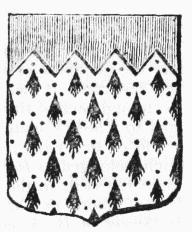
BROME.

ELYNGHAM. (fn. 16)
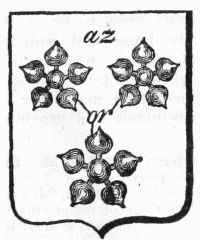
BARDOLPH.
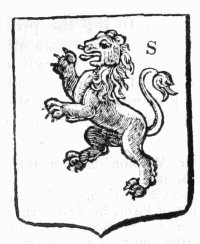
VERDON.
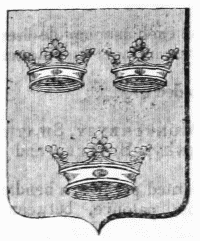
ELY BISHOPRICK.
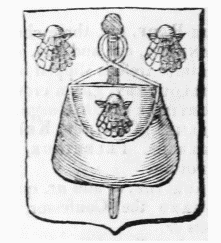
EMBLEM OF ST. JAMES.
